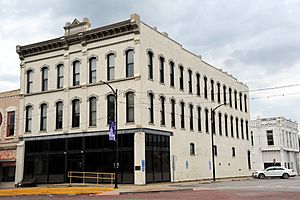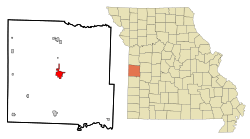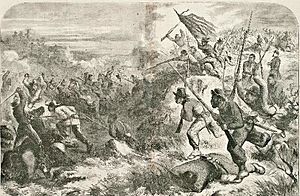Butler, Missouri facts for kids
Quick facts for kids
Butler, Missouri
|
|
|---|---|

Palace Hotel
|
|
| Nickname(s):
The Electric City
|
|

Location within Bates County and Missouri
|
|
| Country | United States |
| State | Missouri |
| County | Bates |
| Area | |
| • Total | 4.08 sq mi (10.56 km2) |
| • Land | 4.07 sq mi (10.53 km2) |
| • Water | 0.01 sq mi (0.02 km2) |
| Elevation | 866 ft (264 m) |
| Population
(2020)
|
|
| • Total | 4,220 |
| • Density | 1,037.62/sq mi (400.64/km2) |
| Time zone | UTC−6 (Central (CST)) |
| • Summer (DST) | UTC−5 (CDT) |
| ZIP Code |
64730
|
| Area code(s) | 660 |
| FIPS code | 29-10054 |
| GNIS feature ID | 2393483 |
| Website | City Website |
Butler is a city in Bates County, Missouri, United States. It's part of the larger Kansas City metropolitan area. In 2020, about 4,220 people lived here.
Butler is the main city, or county seat, of Bates County. It was named after William Orlando Butler, a famous American military and political leader. The city is located about 50 miles south of Kansas City, Missouri on U.S. Route 71-Interstate 49.
Contents
History of Butler
Early Days and County Seat
Butler was first planned in April 1852. John C. Kennett was the first person to build a home there. The official map for Butler was filed in August 1853. It included 55 acres of land that was given to the town.
At first, the county seat for Bates County was a place called Papinville. But in 1855, a large part of the county became Vernon County. This meant Papinville was no longer in the middle of Bates County. So, in 1856, Butler was chosen as the new county seat.
Soon after, workers built a brick courthouse in Butler. It cost $5,000 and was used until 1861. Butler's first general store opened in 1856. More businesses followed before the Civil War began in 1861.
Butler During the Civil War
During the Civil War, western Missouri saw a lot of fighting. Both sides had groups raiding towns. In 1861, a fire destroyed the Bates County courthouse and many nearby businesses. Even the town's first church was burned. This fire was started by a group of Kansas soldiers called Jayhawkers.
Later, in 1862, Union soldiers stayed in Butler for several months. They left in August, and Confederate troops followed them. These groups met a few days later at the Battle of Lone Jack.
Battle of Island Mound
Two months later, an important event happened near Butler. This was the first time African American soldiers fought against Confederates for the Union. It was called the Battle of Island Mound. It happened on October 28–29, 1862.
The Union soldiers were from the 1st Kansas Colored Volunteers. These were former slaves who had escaped from other states. They fought against a larger group of Confederate fighters. The Union soldiers held their ground, and the Confederates left. Eight Union soldiers and many Confederates were killed.
General Order No. 11
On August 25, 1863, Union General Thomas Ewing gave a controversial order. It was called Order No. 11. This order made all people living in the countryside of Bates County leave their homes. It was meant to stop support for Confederate fighters.
People who could prove they supported the Union could move to towns near Union army posts. Others had to leave the counties completely. This order forced many families to leave, including the grandparents and mother of future President Harry S. Truman. Butler became almost a ghost town. When people returned after the war, much of the town was destroyed.
After the War: Rebuilding Butler
After the Civil War, Butler slowly began to recover. A temporary building was used for county business in 1865. In 1869, a larger, two-story brick courthouse was built.
Butler officially became a village on June 19, 1872. Seven years later, on April 7, 1879, it became a city. William Page was the first mayor. Many mills and grain elevators opened in the 1870s. This helped local farmers process their crops.
"The Electric City"
In 1881, Butler got electric power. It was one of the first towns west of the Mississippi River to have electricity. Four large lights were put on top of the Bates County courthouse. They lit up the downtown area. Because of this, Butler became known as "The Electric City."
The 1869 courthouse was used until 1899. It was found to be unsafe and was torn down. A new Bates County Courthouse was built in 1901. This large, Romanesque-style building cost $50,000 and opened in July 1902. By the early 1900s, Butler had three banks, an opera house, four hotels, and many stores.
In 2008, people in Bates County put up a statue and plaque. It honored the 1st Kansas Colored Volunteers and the Battle of Island Mound. In 2012, the State of Missouri bought land where the battle happened. It created the "Battle of Island Mound State Historic Site."
The Bates County Courthouse and the Palace Hotel are both listed on the National Register of Historic Places. This means they are important historical sites.
Geography
Butler is located on US Route 71 and Missouri Route 52. Rich Hill is ten miles south, and Adrian is 8.5 miles north.
The city covers about 4.08 square miles. Most of this area (4.07 square miles) is land, and a very small part (0.01 square miles) is water.
Climate
| Climate data for Butler 4W, Missouri (1991–2020 normals, extremes 1946–present) | |||||||||||||
|---|---|---|---|---|---|---|---|---|---|---|---|---|---|
| Month | Jan | Feb | Mar | Apr | May | Jun | Jul | Aug | Sep | Oct | Nov | Dec | Year |
| Record high °F (°C) | 75 (24) |
79 (26) |
87 (31) |
93 (34) |
95 (35) |
104 (40) |
117 (47) |
110 (43) |
109 (43) |
97 (36) |
83 (28) |
75 (24) |
117 (47) |
| Mean daily maximum °F (°C) | 40.1 (4.5) |
45.7 (7.6) |
56.4 (13.6) |
66.2 (19.0) |
75.7 (24.3) |
84.7 (29.3) |
89.5 (31.9) |
88.4 (31.3) |
80.8 (27.1) |
70.0 (21.1) |
55.8 (13.2) |
44.6 (7.0) |
66.5 (19.2) |
| Daily mean °F (°C) | 30.0 (−1.1) |
34.6 (1.4) |
44.8 (7.1) |
54.7 (12.6) |
65.3 (18.5) |
74.8 (23.8) |
79.3 (26.3) |
77.4 (25.2) |
69.1 (20.6) |
57.5 (14.2) |
44.7 (7.1) |
34.5 (1.4) |
55.6 (13.1) |
| Mean daily minimum °F (°C) | 19.8 (−6.8) |
23.5 (−4.7) |
33.2 (0.7) |
43.2 (6.2) |
55.0 (12.8) |
64.9 (18.3) |
69.1 (20.6) |
66.4 (19.1) |
57.4 (14.1) |
45.0 (7.2) |
33.5 (0.8) |
24.5 (−4.2) |
44.6 (7.0) |
| Record low °F (°C) | −19 (−28) |
−24 (−31) |
−8 (−22) |
12 (−11) |
27 (−3) |
40 (4) |
45 (7) |
44 (7) |
29 (−2) |
18 (−8) |
1 (−17) |
−26 (−32) |
−26 (−32) |
| Average precipitation inches (mm) | 1.61 (41) |
1.95 (50) |
2.76 (70) |
4.55 (116) |
6.26 (159) |
5.62 (143) |
4.37 (111) |
3.75 (95) |
4.31 (109) |
3.45 (88) |
2.86 (73) |
2.10 (53) |
43.59 (1,107) |
| Average snowfall inches (cm) | 2.6 (6.6) |
3.0 (7.6) |
1.2 (3.0) |
0.0 (0.0) |
0.0 (0.0) |
0.0 (0.0) |
0.0 (0.0) |
0.0 (0.0) |
0.0 (0.0) |
0.0 (0.0) |
0.3 (0.76) |
2.4 (6.1) |
9.5 (24) |
| Average precipitation days (≥ 0.01 in) | 7.2 | 6.8 | 9.2 | 10.7 | 12.5 | 10.1 | 8.9 | 8.2 | 7.9 | 8.7 | 7.6 | 6.8 | 104.6 |
| Average snowy days (≥ 0.1 in) | 1.7 | 1.8 | 0.6 | 0.1 | 0.0 | 0.0 | 0.0 | 0.0 | 0.0 | 0.1 | 0.3 | 1.4 | 6.0 |
| Source: NOAA | |||||||||||||
People of Butler
| Historical population | |||
|---|---|---|---|
| Census | Pop. | %± | |
| 1870 | 1,064 | — | |
| 1880 | 2,162 | 103.2% | |
| 1890 | 2,812 | 30.1% | |
| 1900 | 3,158 | 12.3% | |
| 1910 | 2,894 | −8.4% | |
| 1920 | 2,702 | −6.6% | |
| 1930 | 2,706 | 0.1% | |
| 1940 | 2,958 | 9.3% | |
| 1950 | 3,333 | 12.7% | |
| 1960 | 3,791 | 13.7% | |
| 1970 | 3,984 | 5.1% | |
| 1980 | 4,107 | 3.1% | |
| 1990 | 4,099 | −0.2% | |
| 2000 | 4,209 | 2.7% | |
| 2010 | 4,219 | 0.2% | |
| 2020 | 4,220 | 0.0% | |
| U.S. Decennial Census | |||
Butler is part of the Kansas City metropolitan area.
2010 Census Information
In 2010, there were 4,219 people living in Butler. They lived in 1,739 households, with 1,031 being families. The city had about 1,036 people per square mile.
Most of the people (94.5%) were White. About 2.7% were African American, and 0.5% were Native American. About 2.3% of the population was Hispanic or Latino.
In these households, 29.7% had children under 18. About 42.8% were married couples. The average household had 2.30 people, and the average family had 2.97 people.
The average age in Butler was 39.3 years old. About 24.1% of residents were under 18. And 20.9% were 65 or older. The city had slightly more females (53.2%) than males (46.8%).
Education
The Butler R-V School District runs one elementary school and Butler High School. The town also has a public library, called the Butler Public Library.
Notable People
Many interesting people have connections to Butler:
- Wesley Bolin – A governor of Arizona.
- Harvey C. Clark – A brigadier general in the U.S. Army.
- Robert Heinlein – A famous science fiction writer who was born and lived in Butler.
- Charles O'Rear – A photographer and author.
- Randy Pike – A Missouri state legislator.
- Stan Wall – A former baseball pitcher for the Los Angeles Dodgers.
- Warren Dee Welliver – A lawyer and judge who served on the Supreme Court of Missouri.
Images for kids
 In Spanish: Butler (Misuri) para niños
In Spanish: Butler (Misuri) para niños



